Related Content
Content
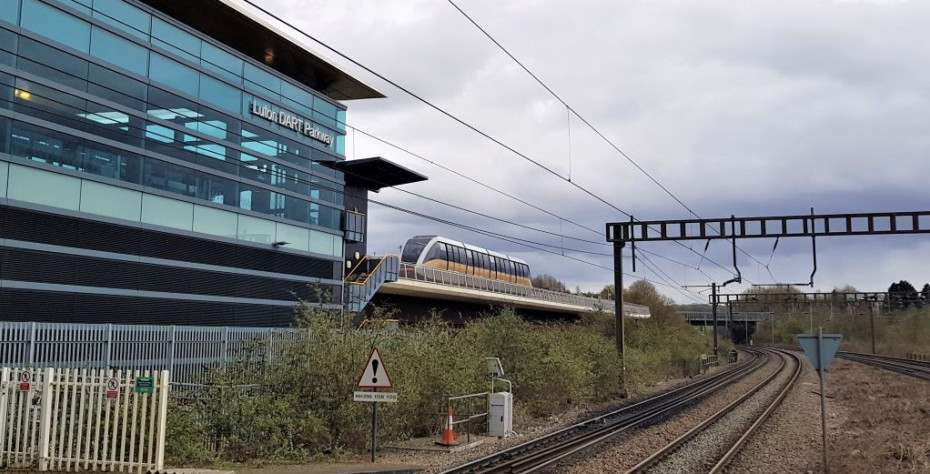
Airport rail links in Great Britain
Find out the options for taking the train from and to a British airport, whether you will be making the transfer from a city centre or a more distant location.
Share
Introduction:
Great Britain lacks an eye-catching airport station, at which high-speed trains can provide alternatives to taking a domestic flight.
However, it can boast a comparatively high number of very useful train to plane connections, which avoid the need to use the roads when travelling to and from multiple airports.
On the list of the Top 20 busiest British airports only Aberdeen, Bristol, East Midlands, Glasgow, Leeds-Bradford and Liverpool don't have either rail stations, or airport operated transfers with the nearest station.
A feature of taking British trains that's typical of European train travel, despite the labyrinth of how British train tickets are sold, is that money saving tickets booked ahead of the travel date, can only be used on the specific train departures selected when booking (the Heathrow Express is an exception).
So they're a great option when travelling long-distance to an airport, but there more of a risk when heading away from them.
That's because they can't be exchanged to a later departure in the event of a flight delay, or a slower than anticipated exit from airport arrivals.
What is atypical about British train travel is that the services are operated by a multitude of different companies, though this tends not to impacts on travelling to/from a British airport by train.
That's because being able to choose between different operators is an unusual scenario on long-distance train to plane routes .
The train operators which serve each airport are also included on the guides below.
A note on train arrival and departure times:
Specific train arrival and departure times on your travel dates should be looked up before you commit to a specific flight.
The times can be looked up on the train company websites included in the guides below, without having to commit to booking a ticket.
The train times included with each airport are a guide to the usual service
They have been featured because check-in times for early morning flights can be earlier than the arrival of the first train of the day at an airport.
Conversely the final train of the day from an airport can be scheduled to depart ahead of late night / early morning flight arrivals.
Also note that on on many rail routes to and from British airports, fewer trains are available on Sunday mornings than at other times of the week.
Birmingham
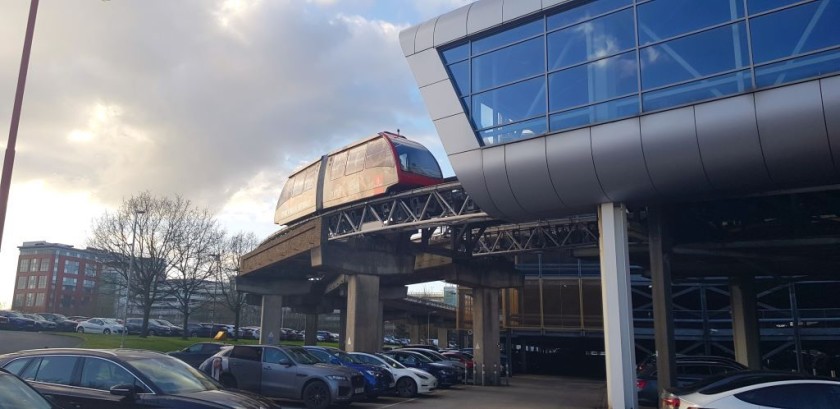
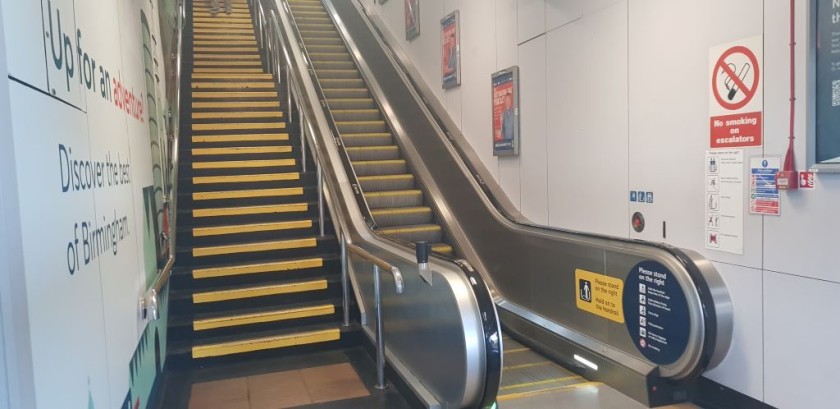
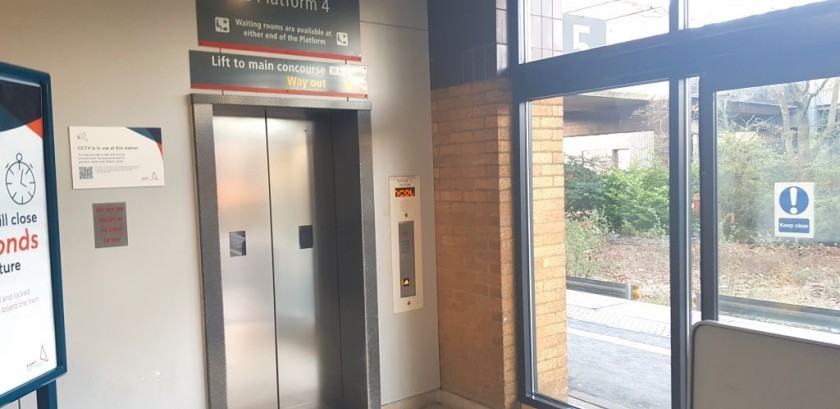
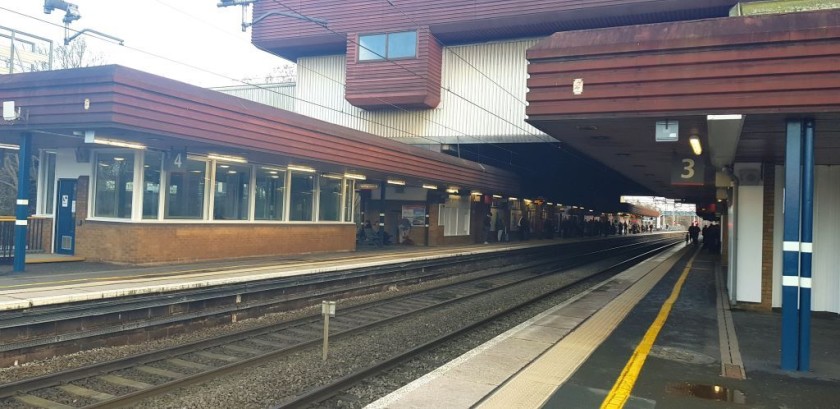
Birmingham International station is connected to Birmingham Airport by a free people mover system, the Air Rail shuttle, which departs every 5 to 10 mins daily from 03:30 to 00:30.
Four train companies offer rail services to and from the station:
- Avanti West Coast
- CrossCountry
- TfW Rail
- West Midlands Railway.
The trains operated by all four companies connect the airport with Birmingham New Street station, so up to 7 trains per hour are available, in a journey time of only 12 minutes.
Up to six trains per hour link Birmingham International station with Coventry in a journey time of 10 minutes.
Multiple more distant cities and towns including, Oxford, Shrewsbury, Stafford and Stoke-on-Trent have their only direct plane to train links at Birmingham Airport.
The airport is also a gateway to exploring Wales by train, due to its direct rail links with multiple locations in mid and north Wales including Aberystwyth, Bangor, Colwyn Bay, Machynlleth and Rhyl.
1: Avanti West Coast
Avanti West Coast operates trains between Birmingham International station and distant destinations such as London, Blackpool, Crewe, Edinburgh, Glasgow, Preston and The Lake District.
Though tickets to/from the stations in Birmingham city centre, Wolverhampton and Coventry can also be used on Avanti West Coast trains.
To/from London Euston:
- Typical journey time = 1hr 10min
- There are currently two trains per hour.
- The first train of the day typically arrives in Birmingham International at around 07:35 on Monday to Saturday, and at around 09:45 on Sunday.
- The final train of the day typically departs from the airport station for London Euston at around 23:20 on Monday to Friday, at around 22:05 on Saturday and at around 23:05 on Sunday.
If your end-to-end journey will be beginning in the Euston area of London, what's useful to know is that none of the London airports have direct rail links with Euston.
So despite the distance, using Birmingham Airport can enable faster end-to-end journeys with some areas of the capital.
To/from Crewe, Warrington, Wigan and Preston:
- Typical journey time: Crewe = 1hr 30min; Warrington Bank Quay = 1hr 50min; Wigan North Western = 2hrs and Preston = 2hr 15min.
- There is typically an hourly service on Monday to Saturday; and eight trains on Sunday.
- The first train of the day typically arrives in Birmingham International at around 10:25 on Monday to Saturday, and at around 14:30 on Sunday.
- The final train of the day typically departs at around 18:45 on Monday to Friday and at around 17:45 on Saturday and Sunday.
- These trains typically continue beyond Preston to a variety of destinations including Blackpool, Carlisle, Edinburgh, Oxenholme Lake District and Penrith North Lakes.
2: CrossCountry
CrossCountry lives up to its name by operating trains which take a Manchester Piccadilly - Stockport - Macclesfield - Stoke-on-Trent - Stafford - Birmingham New Street ↔ Birmingham International ↔ Coventry - Leamington Spa - Oxford - Reading - Basingstoke - Winchester - Southampton - Brockenhurst New Forest - Bournemouth route.
If you won't be travelling with Advance tickets, making seat reservations on these trains is highly recommended. they can be reserved from less than an hour prior to departure.
To/from Stafford, Stoke-on-Trent and Manchester Piccadilly
- Typical journey time: Stafford =50 min; Stoke-on-Trent = 1hr 10min; Manchester Piccadilly = 1hr 50min.
- There is usually one train per hour daily.
- The first train of the day typically arrives in Birmingham International at around 07:10 on Monday to Saturday, and at around 10:15 on Sunday from Manchester and Stafford; and at 11:10 from Stoke-on-Trent.
- The final train of the day typically departs at around 19:40 daily.
- Typical journey time: Oxford =1hr; Reading = 1hr 30min.
- There is usually one train per hour daily
- Up to eight trains per day continue beyond Reading to Bournemouth and make the station calls listed above.
- The first train of the day typically arrives in Birmingham International at around 07:40 on Monday to Saturday, and at around 10:40 on Sunday.
- The final train of the day typically departs at around 22:10 on Monday to Friday; and at 19:10 on Saturday and Sunday.
TfW Rail
TfW Rail operates hourly trains from Birmingham Airport to Shrewsbury, which in alternate hours switch between two routes into Wales;
1: The trains which typically depart in even hours head on to Chester and North Wales with station calls at multiple locations including Colwyn Bay and Bangor.
2. Those in odd hours head towards the Cambrian Coast.
The first train of the day from Aberystwyth, and Machynlleth typically arrives in Birmingham International at around 08:50 on Monday to Saturday, and at around 12:55 on Sunday.
While the first train of the day from Chester arrives before 08:00 on Monday to Friday, at around 09:50 on Saturday and at 11;30 on a Sunday.
The final train of the day to Aberystwyth typically departs after 20:00 daily, while the final train of the day to Chester* usually leaves 21:10 on Monday to Saturday, and as late as 22:40 on Sunday.
*=This final departure of the day doesn't travel beyond Chester.
West Midlands Railway
These are the local and regional trains to and from Birmingham Airport, in addition to Birmingham New Street and Coventry, West Midlands Railway trains also link the airport to Milton Keynes, Northampton, Rugby and Walsall.
They also provide a slower, but typically cheaper, service to London Euston than the Avanti West Coast trains.
Arriving and departing by train at Birmingham International
The station concourse and its link to the Air Rail shuttle are above the railway and two access points connect the platforms / tracks with the concourse:
- By the front of the trains which arrive from Birmingham, so by the rear of the trains heading to the city, there is a lobby which houses an escalator and a staircase - the escalator leads up from the platforms.
- Towards the rear of the trains which arrive from Birmingham, so by the front of trains heading to the city is the lobby which houses a lift /elevator and a staircase - it's on the other side of a Customer Information booth.
When departing by train, as you come through the ticket barriers, you will see the staircases which lead down to each platform / track, but as pointed by the signage, the elevators will be out of sight, behind you.
Cardiff
TfW Rail operates trains to and Rhoose Cardiff International Airport station and Cardiff Airport provides a shuttle bus link to the station.
Though journeys should be planned with care, as the train service is hourly on Monday to Saturday, but only every other hour on Sunday.
The journey time to Cardiff Central station is around 35 minutes, and the trains also call at Cardiff Queen Street.
In the other direction trains head to Bridgend where connections are available to Neath, Swansea and destinations in south-west Wales.
Though if you are planning to travel to the UK to see the best of Wales by train a better option can be making the plane to train transfer at Birmingham Airport, see above, as unlike Cardiff Airport, it has direct trains to multiple destinations in Mid and North Wales.
Edinburgh
If you will be flying into Scotland in order to explore the beautiful country by train, it's highly likely that you will be taking some other form of public transport at the beginning and end of your adventure.
If you will be choosing between flying into Edinburgh and Glasgow, what's good to know is that the airport in Glasgow has no rail link, so the bus has to be used to be make the transfer to/from Central and Queen Street stations
So a tick in the box for using Edinburgh Airport is that it has a tram link to multiple stations in the Scottish capital.
In addition to stopping by Haymarket and Waverley stations, the tram will also call at two stations which are closer to the airport than the city centre;
- Edinburgh Gateway, which has direct trains to multiple destinations on the other side of the Forth Rail Bridge, including, Dunfermline and Kirkcaldy.
- Edinburgh Park, which has direct trains to Dunblane, Larbert and Stirling, plus two trains per hour to multiple stations in Glasgow including High Street, Queen Street and Charing Cross; the journey time to Queen Street is typically around 55 minutes.
Other trains from Edinburgh which head north and west to destinations including Aberdeen, Dundee, Perth and Inverness, call at Edinburgh Haymarket station, after they have departed from Edinburgh Waverley.
So as the tram will call at Haymarket prior to Waverley, making a connection there will offer a faster end-to-end journey when travelling on the routes towards these locations.
The overwhelming majority of the trains which link Edinburgh to other destinations in Scotland are operated by ScotRail.
Though the only British airport which has direct express trains to Edinburgh is Manchester - see below.
Glasgow Prestwick
Glasgow Airport doesn't have a rail link, but as the website for Glasgow-Prestwick airport points out it is the only airport in Scotland directly served by a railway station, a footbridge links the airport terminal with the trains.
On Mondays to Fridays there are typically three trains per hour to and from Glasgow Central station and there are typically two trains per hour at weekends; the journey time is around 45 to 55 minutes.
In the other direction the trains head to Ayr and the journey time is only 10 minutes.
The only other British airport which has direct express trains to central Glasgow is Manchester - see below.
Inverness
At the time of writing Britain's newest station is Inverness Airport station though the station is a 15-20 minute walk from the terminal on a dedicated footpath.
There is also a bus link that operates every 30 minutes, but it is not timed to make specific connections with the trains.
On Mondays to Saturdays trains depart approximately hourly to both Inverness (the journey time is only 10 minutes) and to Elgin, in a journey time of around 35 minutes.
On Sundays there are typically five trains per day to Inverness and seven trains per day to Elgin.
Many trains continue beyond Elgin daily to Aberdeen and these trains also call in Keith and Inverurie.
Liverpool
Liverpool John Lennon Airport doesn't have a rail station and there is no specific shuttle bus link to the nearest station either, but it does have good public transport links to a swathe of destinations across Merseyside and north-west England, hence it's inclusion on this guide.
If you will be heading to and from Liverpool city centre, taking bus route / line 500 is the best option.
The nearest rail station, Liverpool South Parkway, is three miles from the airport.
Bus routes / lines 80A and 86A both link the airport to the station, and combined they typically provide a service every 20 - 30 minutes.
Liverpool South Parkway station has two or four trains per hour to Southport, which connect at Liverpool Central station into other Mersey Rail trains to destinations on The Wirral including Birkenhead, New Brighton and Wallasey.
Up to four trains per hour are available to various stations in Manchester city centre and there are also typically hourly trains to Chester (connect for North Wales), Crewe and Stafford.
London
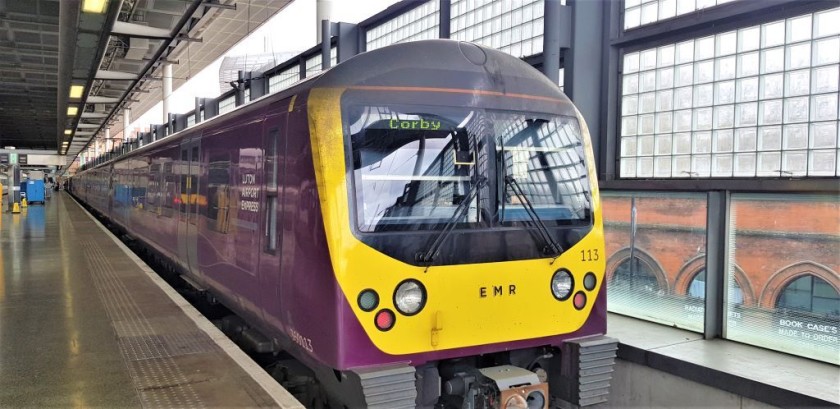
Significant improvements have been made to the rail links at London's airports in recent years;
- the number of rail connections between Gatwick and central London stations has more than doubled, thanks to the expansion of the Thameslink network;
- there has been the opening of the Elizabeth line and its new connection to Heathrow;
- plus there's the new DART people mover which now links Luton Airport's passenger terminal with its station.
- the station at Gatwick Airport has been also been refurbished and expanded.
City
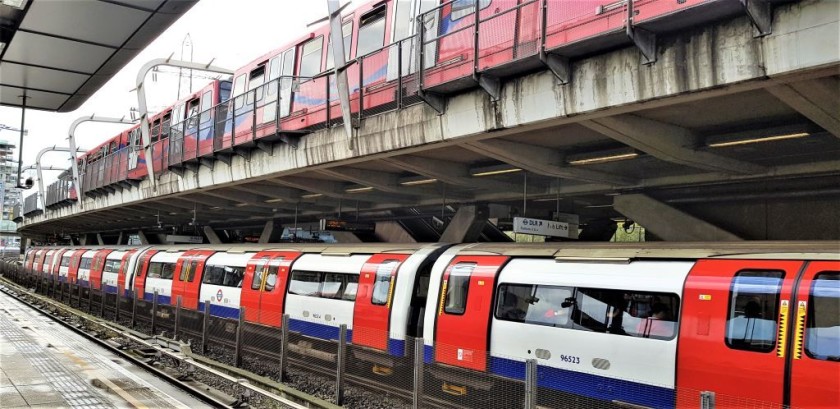
City Airport is directly served by a light-metro system named the DLR which calls at the airport station every 5 to 15 minutes.
The DLR route to/from the airport doesn't serve central London, but step-free connections by escalator and lifts are available with the Jubilee line of the Underground at Canning Town station and with the Central and Elizabeth lines at Stratford.
Access to and from any London station can be looked up on the TfL journey planner.
Stratford station also has direct trains to and from a swathe of more distant destinations in Essex, Suffolk and Norfolk, including Southend-on-Sea, Colchester, Ipswich and Norwich.
Gatwick
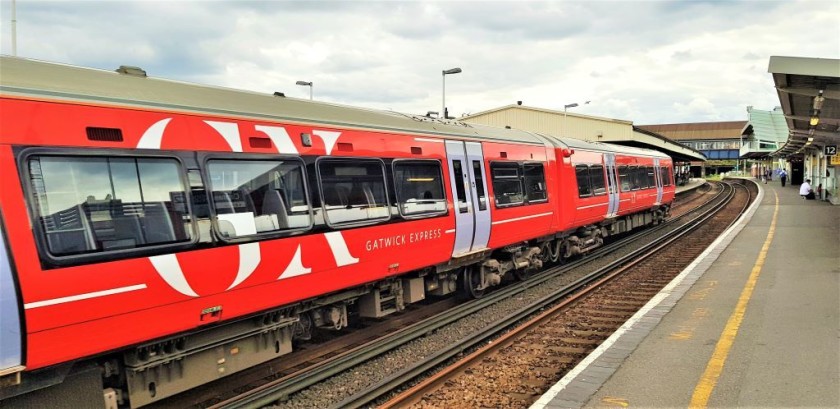
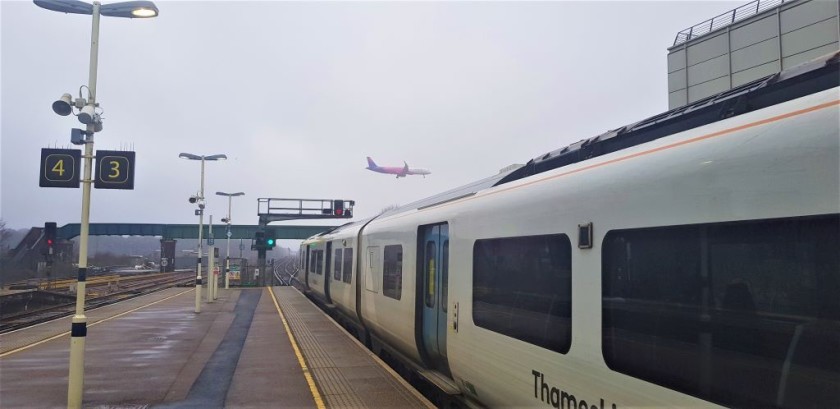
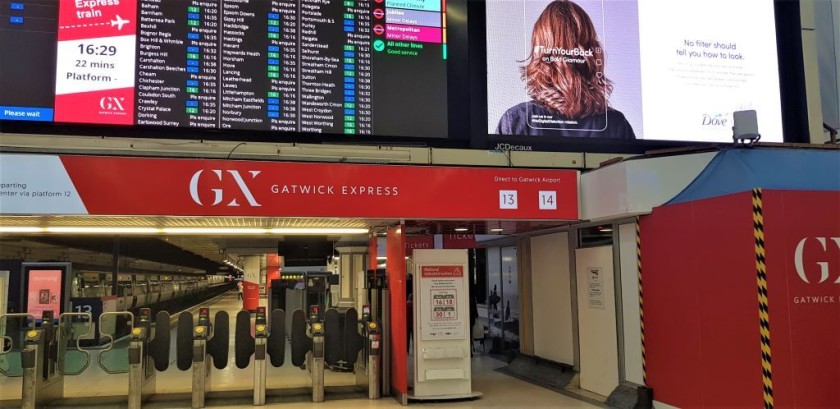
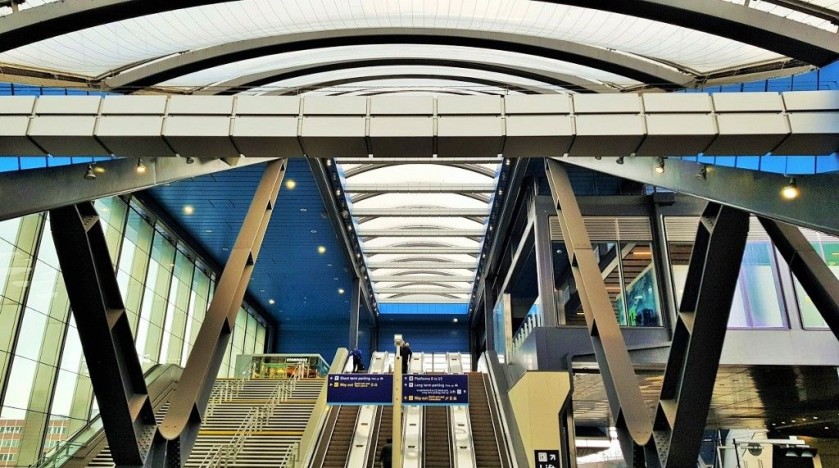
The ticket gates at Gatwick are equipped with Pay As You Go readers which accept bank cards, credit cards, Google Pay, Apple pay and Oyster Cards, so you can use these cards to travel to and from the airport.
However, the amount of money deducted from the cards will match the ticket costs, so you won't save money by using Oyster.
Though you will save likely save time, if you will be heading to London there's no need to queue to use a ticket counter or ticket machine.
Four train operating companies, Gatwick Express, GWR, Southern and Thameslink, provide the services to and from Gatwick Airport station, where the station is directly linked to the South Terminal - and it is connected to the North Terminal by a free people mover.
1: taking the Gatwick Express
Gatwick Express trains share the route to and from London Victoria station with Southern trains, but they are more expensive and therefore require specific tickets - though you can save 10% by booking online in advance; so buying online is cheaper than using Oyster.
Two factors set them apart from the Southern trains:
- They have additional luggage storage.
- They are faster because they are non-stop.
The journey time is scheduled to be 31 minutes, but because they share the same busy tracks as the Southern trains, they are typically only two minutes faster in comparison.
The biggest plus point of taking the Gatwick Express over the Southern trains, used to be that the only stations served by the Gatwick Express trains were Gatwick and Victoria.
When that was the case, they were quieter than the Southern services, so seats could be guaranteed on any departure.
However, the Gatwick Express is now typically a Brighton <> London Victoria service, which happens to call at the airport.
So when heading to London, on arrival at the airport station, the Gatwick Express trains can be busy with travellers who have already boarded in Brighton.
Also because the Gatwick Express trains typically no longer commence their journeys at the airport, the train will only spend a minute at the platform, so there's typically no early boarding available of a near empty train with guaranteed space on the luggage racks.
At Victoria, the Gatwick Express trains share the station with the Southern services, though they have a dedicated pair of platforms /tracks.
These platforms also have a dedicated taxi rank, so when taking a taxi to Victoria station, tell the driver if you want to take the Gatwick Express.
To/from Brighton:
The Gatwick Express now also provides a faster rail link between the airport and Brighton than the alternative Thamesklink services, but the journey time difference can be as little as 3 minutes.
2: taking the Southern trains
Southern Railway offers a more frequent and typically cheaper alternative for journeys between Gatwick Airport and London Victoria station than the Gatwick Express.
Southern also provides the train service between the airport and the major interchange station of Clapham Junction where connections are available to a swathe of locations in west and north London including Hampstead, Putney, Richmond, Shepherd's Bush and Wimbledon.
In the other direction Southern Railway lives up to its name by providing direct trains between Gatwick and multiple locations on the South Coast including Bexhill, Bognor Regis, Chichester, Eastbourne, Hastings, Littlehampton, Southampton and Worthing.
3: taking the Thameslink trains

Up to 8 Thameslink trains per hour connect Gatwick Airport to multiple stations in central London:
- London Bridge; connect for Charing Cross and Waterloo East,
- Blackfriars, for the South Bank arts complex and Tate Modern,
- City Thameslink for St Pauls; this station is closed on Sundays,
- Farringdon connect with the Elizabeth line for Heathrow Airport, Bond Street, Tottenham Court Road, Liverpool Street and Paddington,
- St Pancras Thameslink which serves St Pancras International station and King's Cross station.
All Thameslink trains from Gatwick call at all of these stations before heading on to destinations to the north of London.
One or two trains per hour link the airport to Cambridge and Peterborough.
Up to four trains per hour go to Bedford and these trains all call at the station which serves Luton Airport.
So when heading to central London by Thameslink trains board trains heading to Bedford, Cambridge and Peterborough.
If you will be taking the train to central London it's a good idea to look up the location of your ultimate end destination in the city centre to get an idea of whether heading to Victoria station, or a station served by the Thameslink trains, will be the best option.
Don't assume that taking the Gatwick Express and then a taxi or Underground will be the quickest or easiest route.
Though if you will be travelling from Gatwick to London with heavy luggage by train, something worth knowing is that London Bridge, St Pancras and Victoria stations have dedicated taxi ranks, but Blackfriars, City Thameslink and Farringdon stations don't have them.
If you want to connect into the Elizabeth Line at Farringdon, its stations at Paddington and Liverpool Street have taxi ranks, but they're not available at Bond Street and Tottenham Court Road.
4: taking the GWR trains
GWR provides a daily service which typically departs every 30 minutes for Reading.
At Reading station step-free connections are available to a multitude of destinations to the west and north-west of London including Bath, Birmingham, Bristol, Cardiff, Cheltenham, Coventry, Exeter, Manchester, Oxford and Worcester.
These trains to Reading also call in Guilford; and they reverse direction on departure from Redhill.
Heathrow
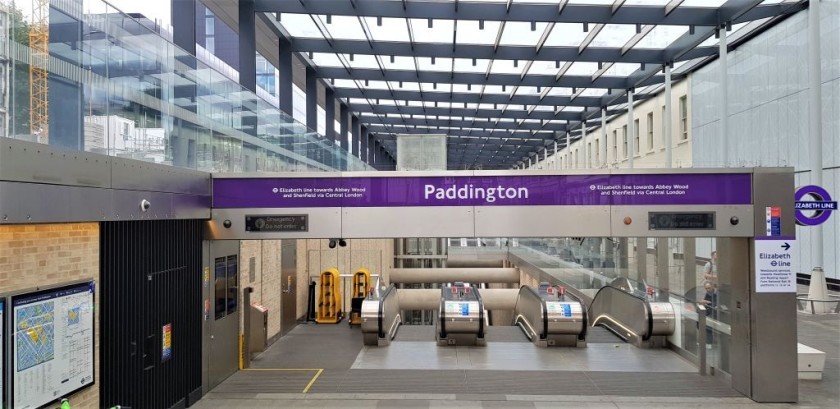
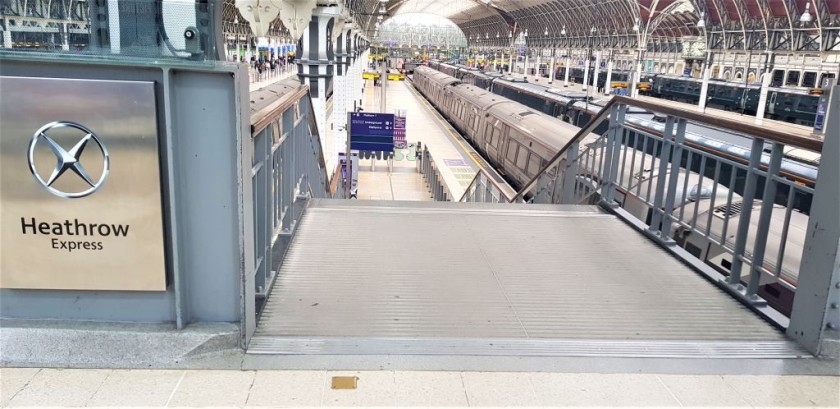
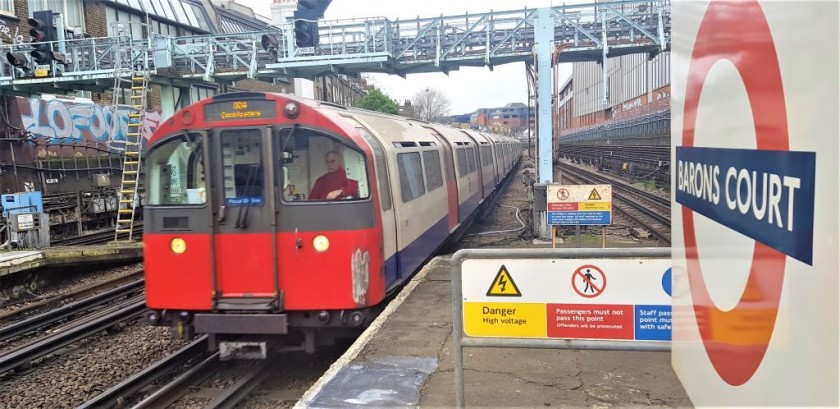
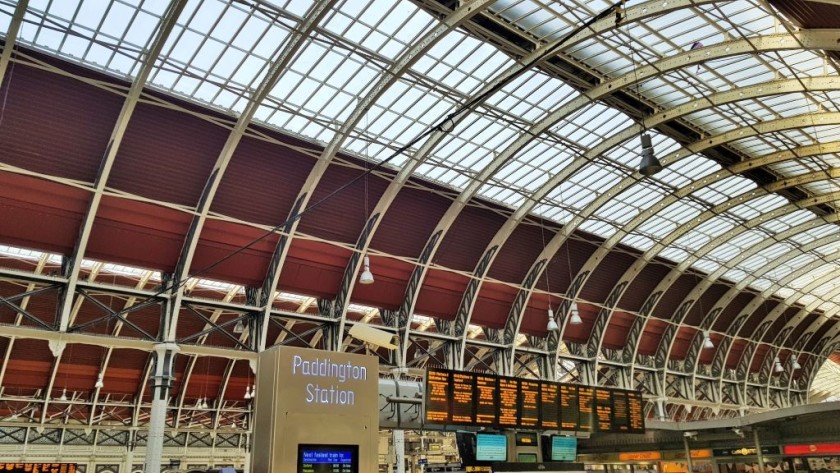
Britain's busiest international airport has three stations at:
- Terminals 2 and 3
- Terminal 4
- Terminal 5
which are all used by the three different train services which connect Heathrow to central London by train
All of the trains to and from Heathrow call at the station linked to Terminals 2 and 3 - Though if you'll be taking the Piccadilly line to Terminals 2 and 3, it's quicker to take a train heading on to Terminal 5.
However, all trains also call at either the station at Terminal 4, OR at the station at Terminal 5 - Therefore particularly when heading to the airport, take care to board the correct train.
The current operating situation and planned works on the Elizabeth line and Piccadilly line can be looked up here.
The current operating situation and planned works on the Heathrow Express can be looked up here.
Heathrow is in the Transport For London zone 6, so Oyster cards and usual Oyster Card rates are valid on Piccadilly line trains, but other fares apply to the Elizabeth Line.
Comparing the three train services:
Ticket costs:
- the Piccadilly line from any central London station = £5.60 with Contactless; £6.70 with a ticket
- the Elizabeth line from Paddington station = £12:20; Contactless and tickets
- the Elizabeth line from other stations in central London = £13.30 with Contactless £15.80 without an Oyster Card
- the Heathrow Express = £15 if booked in Advance online; £25 if booked last minute at the station, the Contactless rate is also £25.
Contactless = touching in and out of ticket gates with bank cards, apps and Oyster cards
Though the child rates differ: Heathrow Express = 15 and under travel free; Elizabeth line and Piccadilly line = 10 and under travel free, 11 to 15 at 50%,
Railcard holders can obtain the usual discounted rates on both the Heathrow Express and the Elizabeth line.
Journey times to and from Heathrow Terminals 2 and 3 station:
- the Piccadilly line to/from Gloucester Road (its closest station to Paddington) = 42 mins
- the Elizabeth line to/from Paddington = 27 mins
- the Heathrow Express to/from Paddington = 16 mins
The trains:
- the Piccadilly line = limited dedicated luggage space, no Wifi, not air conditioned
- the Elizabeth line to/from Paddington = no dedicated luggage space, Wifi, air conditioning
- the Heathrow Express to/from Paddington = lots of large luggage space, WiFi, on board entertainment, air conditioning
Central London stations:
- the Piccadilly line = multiple stations; and those which are particularly distant from the Elizabeth line stations include Knightsbridge, South Kensington and Earl's Court; A step-free easy interchange is available with District line trains to/from central London at Baron's Court.
- the Elizabeth line = Paddington (access to/from the trains is by escalators and elevators) and Bond Street, Tottenham Court Road, Farringdon and Liverpool Street
- the Heathrow Express = Paddington (access to/from the trains is step-free from the main concourse).
Taking the Elizabeth line:
There are typically 4 x trains per hour which take a Abbey Wood - Canary Wharf ↔ Terminal 4 route.
There are typically 2 x trains per hour which take a Shenfield - Stratford ↔ Terminal 5 route.
All trains call at the station which serves Heathrow Terminals 2 and 3, and also at all central London stations, which are:
- Paddington journey time = 34mins, connect for Bakerloo, Circle and Hammersmith & City lines.
- Bond Street journey time = 39mins, connect for Central and Jubilee lines.
- Tottenham Court Road journey time = 41mins, connect for the Northern line.
- Farringdon journey time = 44mins, connect for the Circle, Hammersmith & City and Metropolitan lines, plus Thameslink trains to Brighton, Cambridge, Gatwick Airport and Luton Airport
- Liverpool Street station.
The first train to the airport from the central London stations arrives at around 06:30; and the final train of the day from those stations arrives at around 23:45.
From the airport the first train of the day to the central London stations typically departs at around 05:20 and the final train departs at around 23:05.
Taking the Heathrow Express:
There are typically trains every 15 minutes which travel non stop in both directions between the station at Heathrow Terminals 2 & 3 and Paddington station, with trains every 30 mins from and to both Terminals 4 and 5.
At Paddington the taxi rank is closer to the part of the station used by the Heathrow Express than the Elizabeth line.
When arriving at Paddington, the step free route is by exiting on to the main concourse and turning to the left.
The first and last trains arrive at depart and from the airport at around 05:05; and the final trains of the day arrive at, and depart from Paddington at around 00:10.
Taking the Piccadilly line:
The Piccadilly line provides a direct link between Heathrow and many locations in central London not served by the Elizabeth line.
So despite its relative lack of speed, the journey between Heathrow and Piccadilly Circus station is scheduled to take 48m mins, it can be the best option when travelling from and to the likes of Earls Court, the museums district, Knightsbridge and Covent Garden.
The first train of the day towards central London departs at around 05:10 and the final train of the day is at around 23:45.
When travelling from central London, the first train of the day arrives in the airport at around 06:35.
To the main London stations from Heathrow:
To Euston station for trains to Birmingham; Glasgow; Liverpool and Manchester.
Take the Elizabeth line to Tottenham Court Road and connect there for a northbound Northern line train.
To King's Cross station for trains to Edinburgh; Leeds; Newcastle and York.
AND
To St Pancras International station for trains to Amsterdam, Brussels, Paris, Canterbury, the Kent coast, Derby. Leicester, Sheffield and Nottingham.
Take the Elizabeth line to Farringdon and connect for a northbound Thameslink train to St Pancras Thameslink station, or when that isn't an option, go direct on the Piccadilly line.
To Liverpool Street station for trains to Ipswich and Norwich.
Take the Elizabeth line direct to Liverpool Street.
To London Bridge station for trains to Canterbury, Hastings and the Kent coast.
Take the Elizabeth line to Farringdon and connect for a southbound Thameslink train; though not all trains from Farringdon go to London Bridge.
To the other London Airports from Heathrow by train:
For Gatwick and Luton take the Elizabeth line to Farringdon and connect for Thameslink trains.
For Stansted connect at Liverpool Street between the Elizabeth line and Stansted Express trains, for City Airport connect at Stratford between the Elizabeth line and DLR trains.
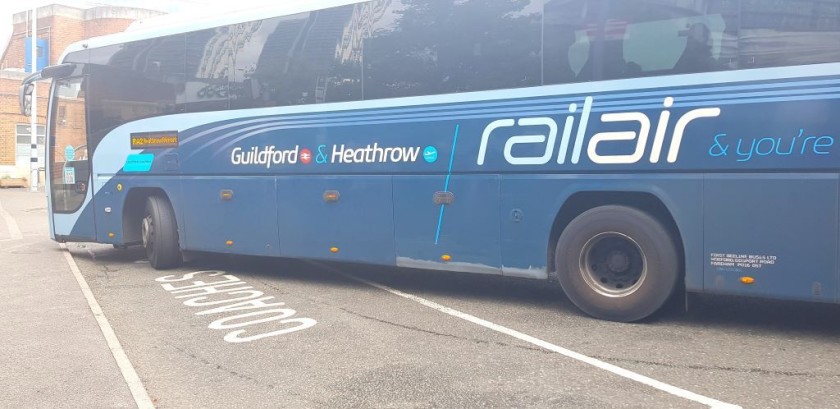
Bus connections to rail stations
All of the train services to and from Heathrow link the airport to the Greater London area, but there are no direct trains between the airport and any other UK city.
When heading to destinations to the west such as Bath, Bristol, Cardiff, South Wales, Devon and Cornwall, rather than heading in the opposite direction to Paddington to board a train, the quicker option is usually to take a Rail Air link bus on route RA1 to Reading station.
Also route RA2 goes to Woking station for connections to Bournemouth, Southampton and Weymouth, and to Guildford station for connections to Portsmouth.
Luton
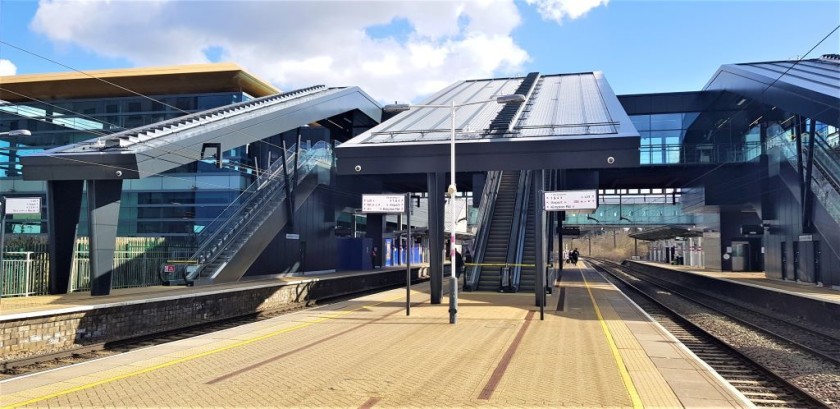
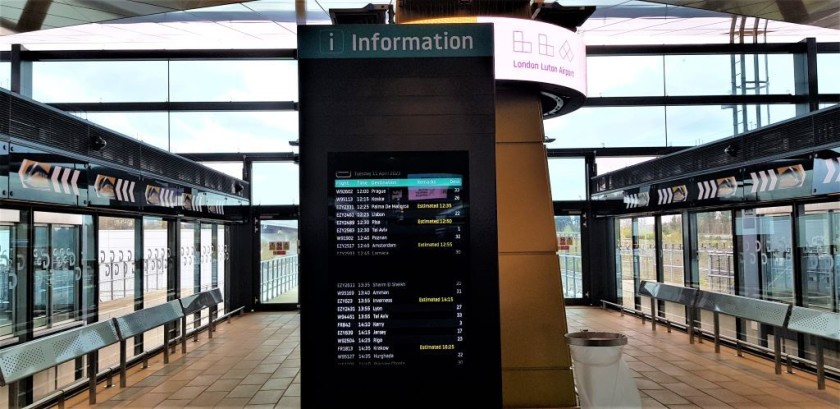
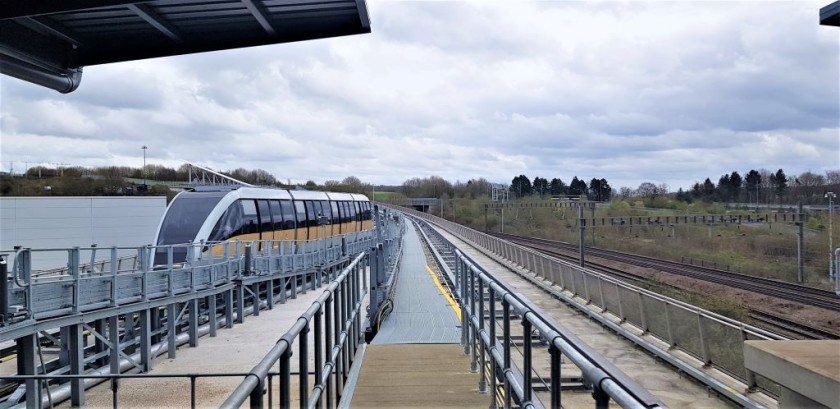
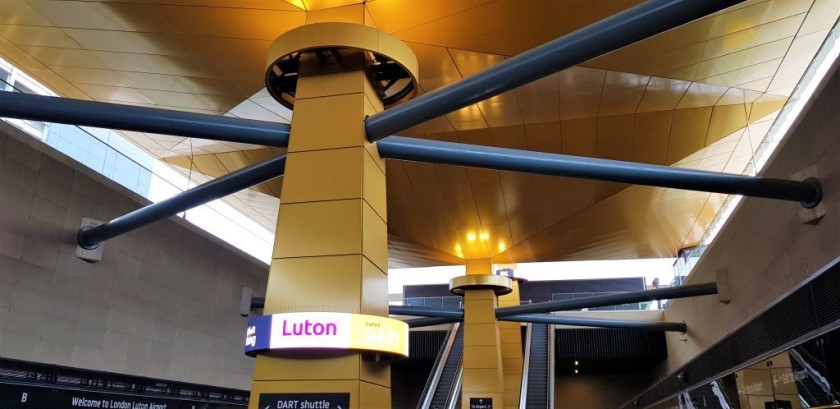

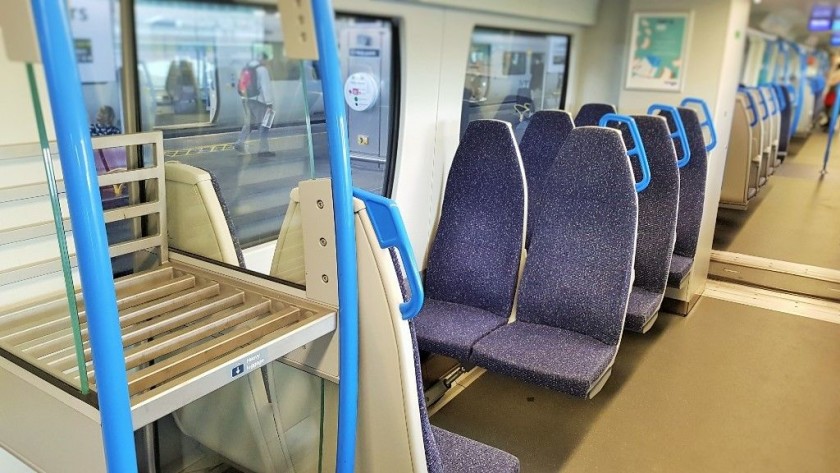
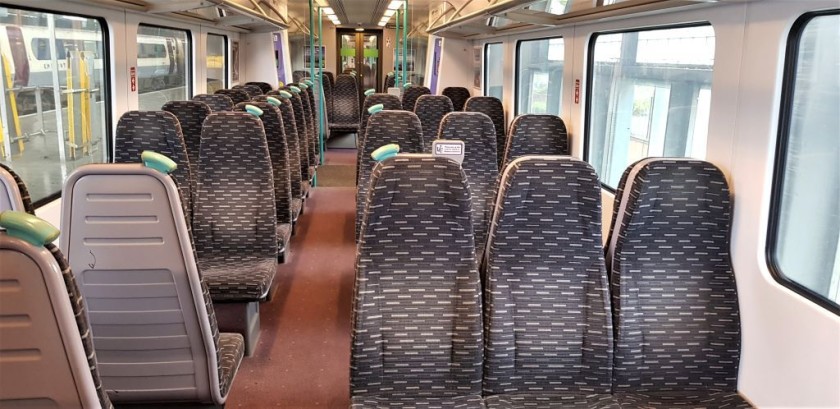
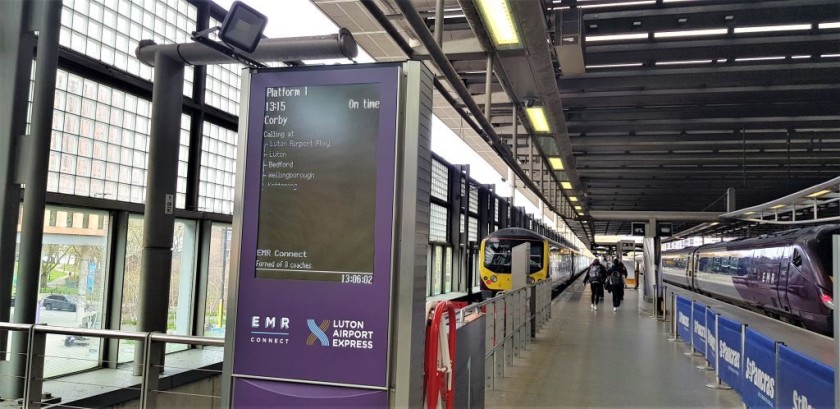
The DART people mover has commenced service between the Luton airport terminal and Luton Airport Parkway station.
When booking tickets select Luton Airport and not Luton Airport Parkway as the to and/or from station, then the ticket(s) will include the journey on the DART; they will open all of the multiple sets of ticket gates that you will pass through.
Three train services are available at Luton Airport Parkway:
- Trains operated by Thameslink
- Long-distance EMR trains to/from destinations north of Luton
- Trains branded 'Luton Airport Express' which are operated by EMR.
Travelling between Luton Airport and St Pancras by train
Both the Luton Airport Express trains and the Thameslink trains connect Luton Airport with St Pancras International station which is located on the northern edge of central London.
In St Pancras International both of these train services use the north end of the main terminal.
The Luton Airport Express trains, which will be heading to Corby depart from the level above the main concourse.
The Thameslink trains depart from platform B on the level below - the faster Thameslink trains will be those which are typically heading to Bedford.
So it doesn't matter which train service you take, regarding how easy it is to transfer to and from taxis, the Underground, or the adjacent King's Cross station.
Though the Luton Airport Express services are non-stop, so have a journey time of only 23 minutes; typically 9 minutes quicker than the fastest Thameslink trains.
The other plus of taking the 'Luton Airport Express trains is that EMR offers discounted Advance tickets, but Thameslink doesn't.
So if you book ahead, the ticket prices for a journey from and to St Pancras can be over 75% less than taking the Thameslink trains.
For this reason if you book a ticket for travel with EMR you can't then opt to travel on a Thameslink train instead; and vice versa, tickets marked Thameslink stations can't be used to travel by the Luton Airport Express.
These Advance tickets are a particularly good option when heading to the airport by the Luton Airport Express, as they can only be used on the specific departure you select when booking.
So if you book an Advance ticket from the airport and then experience a flight delay, you will have to buy another ticket at the airport.
When booking last minute at the station, the same price is charged on the Airport Express and the Thameslink trains, so if you will be buying tickets at St Pancras International or at Luton Airport Parkway stations just prior to boarding, check which service will be the next to depart and book accordingly.
Oyster Cards can't be used to travel between Luton Airport Parkway and central London.
Though the other two key differences between taking a Luton Airport Express train or a Thameslink service are
- the frequency, and
- the the timings of the first and last trains:
- the Luton Airport Express typically departs every 30mins until 21:00 and hourly afterwards.
- Four fast Thameslink trains per hour are usually available; so when heading to London from the airport these fast Thameslink services are the trains heading to Brighton and Three Bridges - avoid the trains heading to Rainham as they call at all intermediate stations.
- the final Airport Express train to St Pancras typically departs Luton Airport Parkway before 23:30 on Monday to Friday and before 22:30 on Sat/Sun, but Thameslink trains are typically available 24 hrs; though the service is only hourly overnight.
If you will be travelling with large items of luggage, something else worth knowing is that the Luton Airport Express trains don't have the type of luggage rack, which is fixed to the floor, but the Thameslink trains do have additional luggage space, capable of accommodating medium sized suitcases.
Though the Luton Airport Express trains have more seats per coach than the Thameslink trains, which matters as both train services can be busy with commuters, when arriving at St Pancras between 08:00 and 09:30 and when travelling away from St Pancras between 16:30 and 19:00.
Travelling between Luton Airport and central London by train
A plus of taking the Thameslink trains to and from Luton Airport is that they cross central London, so call at multiple stations in addition to St Pancras International.
They are:
- Farringdon connect with the Elizabeth line for Heathrow Airport, Bond Street, Tottenham Court Road, Liverpool Street and Paddington.
- City Thameslink for St Pauls; this station is closed on Sundays,
- Blackfriars, for the South Bank arts complex and Tate Modern,
- London Bridge; connect for Charing Cross and Waterloo East.
When the usual service is operating target the faster trains:
- to the airport, they are the trains typically heading to Bedford,
- from the airport, they are the trains typically heading to Brighton or Three Bridges or East Grinstead.
Travelling between Luton Airport and more distant destinations by train
Up to 4 x trains per hour connect Luton Airport with Gatwick Airport, the journey time is around 1hr 20mins and typically 2 x trains per hour travel to and from Brighton, in a journey time of around two hours.
Two Thameslink trains per hour connect Luton Airport with Greenwich and destinations in North Kent including Rochester and Chatham; at Luton Airport Parkway these are the trains which are typically heading to Rainham.
A sporadic train service is also provided by EMR between Luton Airport Parkway and destinations to the north, including Derby, Leicester, Nottingham and Sheffield - the timings below should be confirmed on the EMR website prior to booking flights.
All of the trains listed below call at Leicester.
Monday to Friday:
- 00:55 to Derby (not Monday)
- 23:46 to Derby and Sheffield
- 06:13 arrives from Derby (not Monday)
- 23:16 arrives from Nottingham
Saturday:
- 00:54 to Derby
Sunday departures:
- 09:32 to Nottingham
- 10:02 to Derby and Sheffield
- 10:33 to Nottingham
- 11:03 to Derby and Sheffield
- 11:33 to Nottingham
- 12:03 to Nottingham
- 12:57 to Nottingham
- 13:57 to Nottingham
- 21:57 to Derby
- 22:54 to Nottingham
- 23:30 to Derby
Sunday arrivals:
from Derby at 08:38; 09:37
from Nottingham at 09:07; 10:08; 11:07; 11:54; 21:31 and 22:46
from Derby and Sheffield at 10:39; 11:36 and 2238
Though in most hours daily the trains travelling between Luton Airport Parkway and Corby, connect in Kettering with trains to and from Leicester, Loughborough and Nottingham.
Stansted
Three services provide the trains to and from Stansted Airport station, which is directly linked to the airport terminal; the Stansted Express, Greater Anglia and CrossCountry.
1: Taking the Stansted Express:
The Stansted Express is the rail link between the airport and central London, four trains per hour travel to and from Liverpool Street station in a journey time of around 45 - 50 minutes; the airport is some distance from the city.
The trains also call at Tottenham Hale station where a step-free transfer with the Victoria line of the Underground is available; Liverpool Street is located towards the eastern edge of the city centre, but the Victoria line serves the West End.
Though a new, easier route is available when travelling between Stansted and the Oxford Circus area, as Elizabeth line trains provide a connection with Liverpool Street.
The first Stansted Express train of the day arrives in the airport at around 05:40 and the final departure of the day is typically at 00:30.
Something to note is that the Stansted Express website sells discounted Advance tickets which can be used very differently to how this type of ticket can be used on other British journeys.
That's because the Stansted Express Advance tickets aren't valid on a specific departure / train - instead they are valid on the selected travel day.
So you can save money by booking ahead for your rail travel on your flight dates, but will have the peace of mind of being able to travel on any departure that day!
2: Taking the Greater Anglia trains:
Greater Anglia provides trains which typically operate hourly and link the airport station with Cambridge, Ely and Norwich.
3: Taking the CrossCountry trains:
CrossCountry operates trains on a Stansted Airport - Cambridge - Ely - Peterborough - Leicester - Birmingham New Street route.
Connections are available at Peterborough with trains to/from Leeds, York, Newcastle and Edinburgh; and connections are available at Leicester with trains to/from Derby, Nottingham and Sheffield.
Though the train service pattern varies by direction and day of the week.
There are typically trains every hour on Monday to Saturday.
However, on Sundays the first train of the day doesn't arrive at the airport station until around 14:45 and the first departure of the day is at around 11:20.
Manchester
Three train operating companies provide the services to and from Manchester Airport station, which is directly linked to the airport terminal; Northern, TfW Rail and TransPennine Express.
Unfortunately staffing issues are resulting in many of the services operated by Northern and TransPennine Express being subject to short notice cancellation.
So, particularly when travelling to the airport from more distant locations, it's a good idea to plan a journey based on taking the departure prior to that which you would have otherwise taken.
1: taking the Northern trains
Northern typically provides an hourly service to/from Manchester Airport on five routes
- to and from Bolton - Preston - Blackpool (not Sundays and two trains per hour are available in some hours on Monday to Friday)
- to and from Bolton - Preston - Lancaster; most trains continue beyond Lancaster to/from Barrow-in-Furness, but some trains provide a direct service to/from Bowness on Windermere.
- to/from Crewe (not Sundays)
- to and from Liverpool Lime Street via Rainhill*
- to/from Manchester Piccadilly*; the only trains to/from the airport which use platforms/tracks directly linked to the main concourse in Piccadilly station (not Sundays).
*= these are local trains which call at of the stations between the airport and the city centre.
2: taking the TfW Rail trains
TfW Rail typically operates hourly trains on Mondays to Saturdays only which take a Manchester Airport - Warrington - Runcorn East - Chester - Rhyl - Colwyn Bay - Llandudno route.
3: taking the TransPennine Express trains
TransPennine Express operates hourly trains daily on two routes:
- to/from Huddersfield, Leeds, York, Middlesbrough, Redcar and Saltburn.
- to from, Preston, Lancaster, Oxenholme Lake District, Penrith North Lakes and Carlisle, with trains alternating between serving Edinburgh in one hour and Glasgow the other.
Typical journey times are:
- Blackpool = 1hr 35mins
- Edinburgh and Glasgow = 3hr 35mins
- Leeds = 1hr 25mins
- Llandudno = 2hr 30mins
- York = 1hr 55mins
Between the airport and the city centre
Manchester Airport and the city centre are linked by up to 7 x trains per hour and the journey time is only 14 minutes.
Though there is no specific Airport train service, all of these trains travel via central Manchester while on route to and from other cities and towns.
To central Manchester
When heading from the airport by train, check the location of your final destination in Manchester city centre.
All of the trains call at Piccadilly station, but it may not be the most convenient station for your final destination; so don't assume that leaving a train there will be the best option.
All, but one of the trains per hour to Piccadilly will also call at Oxford Road station and the trains heading to Barrow, Blackpool, Liverpool and Windermere will also call at Deansgate which has an interchange with trams heading towards Altringham, Media City and Eccles.
However, only one train per hour, the train which typically heads to Saltburn and York, now links the airport to Manchester Victoria station.
If you will be heading to the area around Victoria station and this train isn't about to depart, take a a train to Piccadilly and connect for a Metrolink tram heading to Bury.
The final train of the day to Piccadilly station typically departs from the airport at around 00:35 on Monday to Saturday and at 23:35 on Sunday.
From Manchester Piccadilly station:
All of the trains from the city centre connect Piccadilly station to Manchester Airport.
However, at Piccadilly all but one of these hourly trains to/from the airport depart from platform (track) 13, which is some distance from the main concourse and therefore has comparatively awkward access.
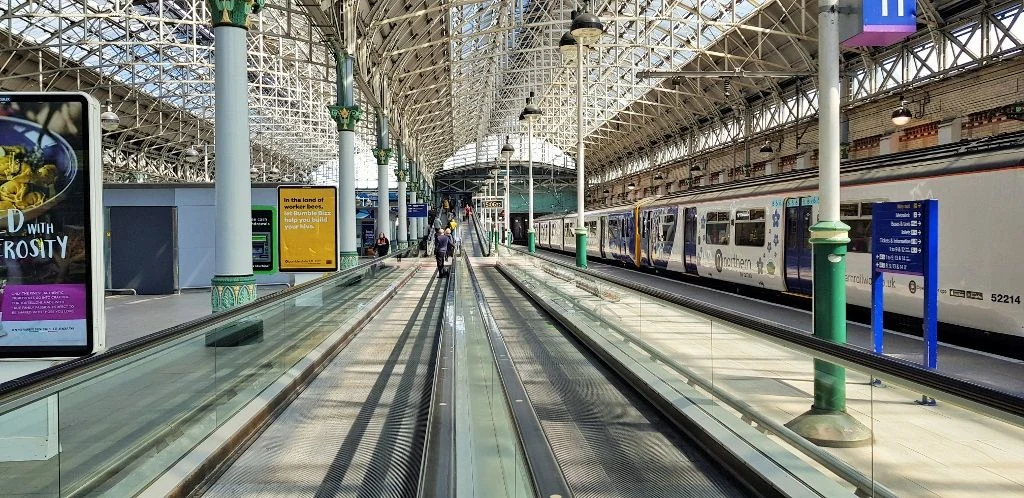
So you need to allow a minimum of 3 – 5 minutes between exiting the main concourse and boarding your train.
A series of moving walkways on platforms (tracks) 10 and 11 link the concourse to a bridge at the opposite end of the station which spans the railway lines; there is also a less obvious lift (elevator) at the mid-point of platform 10, which leads up to this bridge.
This bridge across the station is the location of the ‘Platform 13 and 14 Lounge’, which houses a coffee/snack bar and toilets, seats are also available.
The idea is that you wait in this lounge for your train instead of waiting on the platform/track.
A traffic light system is used on the main departure board housed within this lounge;
- purple = wait in the lounge,
- blue = 'prepare to go' because your train will be within the next 5-10mins (this tends to be used at only busy times)
- green = go to the platform now, because this train will be next to depart.
Platforms 13 and 14 have their own separate ‘traffic-light’ systems.
There are separate sets of stairs to the 'a' the 'b' end of the platforms, the trains from platform (track) 13 normally use the 'a' ends - so the usual system is that travellers are directed to one staircase to access platform 13, while the other staircase (over to the right) is for platform 14.
However, only one lift/elevator leads down to the platform (track); 13 is one side and 14 is on the other; therefore queues can build up for this elevator, so if you want to use it, ignore the ‘traffic-light’ system and be waiting by the elevator around 10 mins before your train is due to leave.
Though if you take a taxi to Piccadilly, ask the driver to take you to the taxi drop-off point on Fairfield Street and don't head into the main part of the station, instead use the elevator on the right hand side of the taxi rank, which leads up to the part of the station that the trains to the airport depart from.
The first train of the day typically arrives in the airport at around 04:05 on Monday to Friday, at around 04:45 on Saturday, but at around 07:55 on Sunday.
Newcastle
Newcastle Airport is linked to the city centre and both Gateshead and Sunderland by the Green Line of the Newcastle Metro.
The city centre stations in Newcastle are Haymarket and Monument
There is also a Metro stop at the city's central railway station which offers a step-free connections with trains to and from more distant destinations including Berwick-upon-Tweed, Carlisle, Darlington, Durham, Hartlepool, Middlesbrough, Morpeth and York.
The Metro trains typically operate to and from the airport every 12 minutes during the day on Mondays to Saturday and every 15 mins on evenings and all day on Sunday, with the final departure from the airport being shortly after midnight.
The first train of the day arrives in the airport before 06:20 on Monday to Friday; at around 06:45 on Saturday and at around 07:10 on Sunday.
Southampton
Southampton Airport Parkway station is steps away from the airport terminal.
The station is served by trains operated by South Western Railway and CrossCountry.
The South Western services provide typically twice hourly links daily to and from and swathe of locations in addition to Southampton Central station, including Bournemouth, Romsey, Weymouth, Winchester and Waterloo station in London.
CrossCountry typically provides up to eight trains per day on a Bournemouth - Southampton Central - Southampton Airport - Reading - Oxford - Coventry - Birmingham International for Birmingham Airport - Birmingham New Street - Stafford - Stoke-on-Trent - Manchester Piccadilly route.

Simon Harper
I wanted to share my passion for train travel and explain how anyone can take the fantastic journeys I have taken.

This is one of more than 100 train travel guides available on ShowMeTheJourney, which will make it easier to take the train journeys you want or need to make. As always, all images were captured on trips taken by ShowMeTheJourney.
This second version of ShowMeTheJourney is exciting and new, so we are genuinely thrilled that you are here and reading this, but we also need your help.
We’re striving not to let anything get in the way of providing the most useful service possible, hence a facility has been set up with DonorBox which can be used to support the running costs and make improvements.
Instead of advertising or paywalls, your financial support will make a positive difference to delivering an enhanced service, as there’s a lot of ideas which we want to make happen.
So if you have found the info provided here to be useful, please consider saying thank you.



